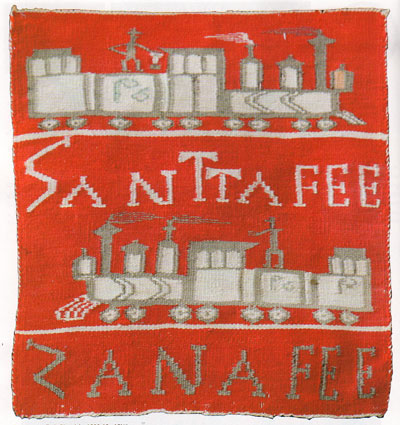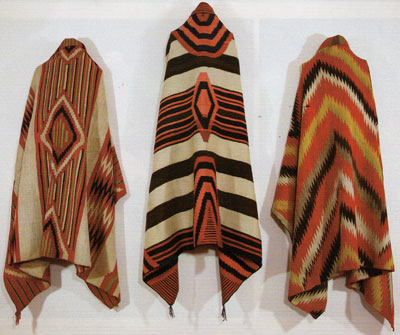Masterpieces from the Loom, Navajo Blankets, Western Art Collector
By Medicine Man Gallery on

Masterpieces from the Loom: Navajo Blankets 1860-1900
by Dr. Mark Sublette
Reproduced courtesy of Western Art Collector magazine, February 2011

Navajo Third Phase Chiefs Blanket with Ravelled Bayeta and Indigo, c. 1870, 54" x 70"
Energy, color, and texture are elements found in all Navajo blankets. The wool of the Churro sheep is soft with long supple fibers giving most wearing blankets from the 19th century a special feel collectors covet. Masterpieces From the Loom: Navajo Blankets 1860-1900 is an exhibit dedicated to the weaving prowess of the Navajo from the 19th century. The show encompasses the entire range of weaving styles from 1850 to 1900.
The earliest textile in the exhibit is a Navajo poncho, which has an unusual slit located in the center of the blanket. This art form is rare with probably less than 50 in existence. Navajo ponchos, with their Mexican Saltillo-like composition, are unique to Navajo weaving and are extremely fine blankets. These blankets, or serapes, would generally take nearly a year to weave and are composed of natural dyes, bayeta and homespun yarns. The red, a favorite color of the Navajo weavers, is painstakingly obtained by unraveling fine strands of trade cloth also known as bayeta. The early bayeta found in ponchos was dyed with either lac or cochineal dyes and made a dark crimson color. Iridescent blue and green come from Indigo dyes mixed with natural yellows usually from local desert snakeweed.

Navajo Transitional Blanket, c. 1900-10, 74" x 50.5"
A great classic serape from the Axtell collection is also for exhibit and sale. This blanket is composed of natural dyes, bayeta and has stellar provenance coming from the family of Samuel Beach Axtell, governor and Chief Justice of the Supreme Court of the Territory of New Mexico (1875-1878).
Chief Blankets also grace the exhibit with numerous examples including a Second Phase Chief Blanket with typical 12 piano key design elements. Second Phase Blankets date from the 1850-70 timeframe and, much like ponchos, are composed of natural dyes and Churro yarns. A large number of Third Phase Chief Blankets ranging from crosses, diamonds and blocks are represented including early 1860s examples through transitional. The early blankets are composed of natural dyes, unraveled trade cloth or bayeta and are extremely fine in composition. Four stellar examples of Chiefs Blankets are available for the very first time and were originally purchased from an old trading post located in southern Utah. The blankets have remained in the same family collection since they were acquired.

Navajo Germantown Train Pictorial, c. 1890, 19" x 16.5"
The blanket period which lasted for a half-century, also includes pieces made from Germantown yarns, which collectors now refer to simply as “Germantowns.” This yarn, from Germantown, Pennsylvania, was a commercial yarn and was used more for its tight, colorful nature than its wearing capabilities. Germantown weavings in the show include a rare small sampler with two trains, men shoveling coal and the words “Santa Fe” misspelled highlighting the fact the Navajo weaver couldn’t speak or write English. There are also numerous Eye dazzler Germantown weavings, which use a multiplicity of color in a sizzling array thus evoking the vertigo, nystagmus-producing “Eye dazzler.”
One early 1870 Child’s Blanket whose original collection history dates to the Arizona territory is also featured in the show. This child-size serape is unique not only for its stellar history but also for its extremely fine weave and dramatic design.
The show, which focuses on early Navajo blankets, ahs the distinction of being complemented by artist Ray Roberts’ original oil paintings, which depict many of the weavings in the exhibit showing their grace and beauty. Roberts’ attention to detail and color sensibility allows the viewer to get the truest sense of how these amazing blankets appeared to their makers: masters of the loom.

Left to Right: Navajo Classic Serape with all natural dyes, c. 1860, 73" x 52", Navajo Third Phase Chiefs Blanket with Ravelled Bayeta, Cochineal, Lac and Indigo dyes, c. 1870, 50" x 76.5", Navajo Transitional textile, c. 1880, 73" x 53"